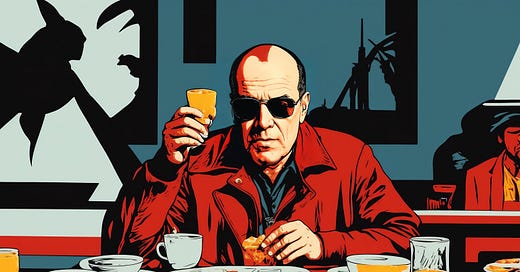Last weekend my wife and I found ourselves staying at a bed and breakfast on Greenwood Lake. When she told me she loved breakfast, I told her "no, THIS guy loves breakfast." I pulled up the radical Hunter S. Thompson quote and read it to her as we waited for some eggs and bacon.
“Breakfast is the only meal of the day that I tend to view with the same kind of traditionalized reverence that most people associate with Lunch and Dinner. I like to eat breakfast alone, and almost never before noon; anybody with a terminally jangled lifestyle needs at least one psychic anchor every twenty-four hours, and mine is breakfast. In Hong Kong, Dallas or at home — and regardless of whether or not I have been to bed — breakfast is a personal ritual that can only be properly observed alone, and in a spirit of genuine excess. The food factor should always be massive: four Bloody Marys, two grapefruits, a pot of coffee, Rangoon crepes, a half-pound of either sausage, bacon, or corned beef hash with diced chiles, a Spanish omelette or eggs Benedict, a quart of milk, a chopped lemon for random seasoning, and something like a slice of Key lime pie, two margaritas, and six lines of the best cocaine for dessert… Right, and there should also be two or three newspapers, all mail and messages, a telephone, a notebook for planning the next twenty-four hours and at least one source of good music… All of which should be dealt with outside, in the warmth of a hot sun, and preferably stone naked.”
As I read it, she was hooked, with intermittent gasps, eye-widens, and crack-ups. Our table was soon filled with plates, and it felt wimpy compared to the legend we just heard. This breakfast ritual is absurd enough to grab anyone's attention. But behind the hyperbole is an unconscious mastery of craft. It's the difference between a crazy idea and a classic.
This was written in 1979, six years after Fear and Loathing in Las Vegas, and two decades after that time where he notoriously rewrote Hemmingway novels (while speaking them out loud). I imagine this 215 word piece was blurted out in around 25 minutes, perhaps under the influence of eggs and cocaine, and in a rush to meet a deadline for Lapham's Quarterly.
Even if the act of making this happened in a flash, there's a lot we can learn from carefully analyzing Hunter's writing mechanics. We're about to dive deep into an analysis that is six times longer than the piece itself. The goal here is to identify the rational patterns behind emotional resonance.
Subscribe to unlock this post, and everything else featured in my Craft section.
Here are the takeaways well unpack below.
If our essay contains a series of ideas, we should consider not just how we arrange them, but how far we unpack each one.
I know what it feels like when a sentence starts normally, but then hits you in the face with a punchline from left field.
We can write sentences at near infinite length if we consider how each phrase builds momentum into the next one.
Capitalizing words that typically don't get upper-cased can bring flat words to life, especially if you add context clues.
When you repeat a distinct phrase at the beginning and end of an essay, it implies resolution, and also gives the opportunity for a surprise ending.
Keep reading with a 7-day free trial
Subscribe to Essay Architecture to keep reading this post and get 7 days of free access to the full post archives.




